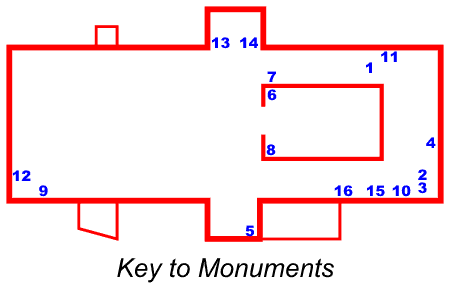For this church:    |
Newark St Mary MagdaleneMonuments and MemorialsThere are many monuments in the church. This page includes some of the most interesting ones. |
 Drawing
of the Drawing
of theAlan Fleming brass |
This brass, measuring 9'4" by 5'7" is one of the four largest “Flemish” brasses in England. Rather than being a single piece, it comprises sixteen small panels in three columns (five in the outer two, and six in the central column) - the bottom right panel has been restored. It depicts Alan Fleming with hands folded in prayer. The canopy about him contains figures of saints and angels as well as mourners or “weepers”.
Alan Fleming was a wool merchant, and he founded a chantry in the Corpus Christi chapel in 1349. His wife, Dame Alice, endowed the Chantry House.
The brass has had several locations. Originally it was on the tomb of Alan Fleming in the Holy Trinity Chapel (then in the south transept). In 1823 it was moved to what is now the Lady Chapel, and placed on the back of the reredos behind the High Altar. This action was not universally popular. The nineteenth century architectural draughtsman and antiquarian T Kerrich was moved to record the event as follows: “They have taken [the brass] off the stone, which they have removed and propose to sell, and have put up the brass like a picture, behind the E end of the choir by way of preserving it, but they took care to spoil it first by scouring it. This Man is believed to have been a great benefactor to the church, if not the Founder; & to reward him & show their gratitude they have taken away his gravestone from over his body !!!”
Later in the nineteenth century the brass was moved back to the south transept and hung on the wall, where it remained until the middle of the twentieth century. In 1951 it was removed to make room for the Robert Kiddey War Memorial sculpture, and placed in its present location on the ground in the north choir aisle.
 Brass
of John Boston Brass
of John Bostonin the Holy Spirit Chapel |
2 John Boston (1540)
The identification of this brass is not quite certain. It certainly depicts a man in the dress of about 1540, and was referred to by nineteenth century writers as an “unnamed young man”, but since the middle of the twentieth century there has been a tendency to identify him as “John Boston”, following clues in Thoroton.
Thoroton records the existence in his time, in the north aisle, of two portraits with the Drapers’ Arms over them, identified by inscriptions as John Boston and his son William Bole, which William died in 1551. Cornelius Brown describes the present brass as located on the floor of the north transept, with a mutilated coat of arms at its foot, depicting “three tiaras, two and one, emitting rays”.
The figure, just over 18½” in height, was moved with the shield to the Holy Spirit Chapel in 1951.
 Monochrome
picture Monochrome
pictureof the Phyllypott brass, clearly showing the design |
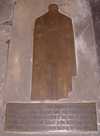 Photograph
of the brass Photograph
of the brass |
3 William Phyllypott (1557)
The larger of the two brasses on the floor of the Holy Spirit Chapel depicts William Phyllypott, who died in 1557. It was originally sited in the south transept, where it remained until 1811. It was then transferred to the wall at the west end of the north aisle. Trollope asserts that formerly it had been inserted, with an epitaph and an effigy of William’s wife, into a slab covering their joint grave. In 1951 the effigy of William and the epitaph were moved to their present position.
The brass is just over 30½" high, and shows William Phyllypott in a fur-lined gown with hanging sleeves.
William Phyllypott was founder of the Bede Almshouses, which formerly stood in Barnbygate.
Altar Tombs
 4
Robert Brown (1532)
4
Robert Brown (1532)
Robert Brown’s tomb is now in the Lady Chapel. It was originally in the Holy Trinity Chapel, which was in the south transept. It is an altar tomb of dark grey marble, panelled and decorated with coats of arms, which were restored in their correct colours in 1976. There is an inscription on top which can be translated as follows:
Here lies Robert Brown, Esquire, and Agnes his wife, lately Alderman of the Guild of the Holy Trinity of this church, and Constable of the Castle, and Principal Steward of the Freedom of this town, and also receiver of Thomas Wolsey, Cardinal of York, and Lord John Longland, Bishop of Lincoln, besides Sheriff of the Counties of Nottingham & Derby & also Keeper of the Rolls in the County of Nottingham and the parts of Kesteven in the County of Lincoln. Which Robert died the 10th day of the month of December in the year of Our Lord 1532. On whose soul may God have mercy.
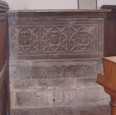 5
Anthony Forster (1559)
5
Anthony Forster (1559)
The altar tomb that remains in the south transept has no visible inscription, but it is believed to be that of Anthony Forster, the first Alderman of the Incorporated Borough.
Seventeenth Century Coloured Effigies
 Effigy
of Robert Ramsey Effigy
of Robert Ramsey |
 Detail
of the inscription Detail
of the inscriptionbelow the effigy |
6 Robert Ramsey (1639)
This is located in the north-west corner of the chancel. The cartouche above the effigy contains Ramsey’s arms. The implication of the epitaph may be that he was killed by lightning.
 Memorial
to John Johnson Memorial
to John Johnsonin the north choir aisle |
 Detail
of the inscription Detail
of the inscriptionon the memorial |
7 John Johnson (1659)
This can be found on the pillar in the south-west corner of the north choir aisle. John Johnson was Mayor of Newark in 1635 and 1639, and by his will established a charity for poor widows, and also for the maintenance of the church windows.
 Monument
to Thomas Atkinson Monument
to Thomas Atkinson |
 Detail
of the inscription Detail
of the inscriptionon the Atkinson memorial |
8 Thomas Atkinson (1661)
Thomas Atkinson was a leader of the inhabitants of Newark during the Civil War, and was Mayor in 1641. The Latin inscription on the memorial sings his praises in glowing terms. It is located in the south-west corner of the chancel.
Other Important Memorials
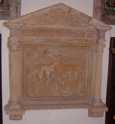 9
Anne Markham (1601)
9
Anne Markham (1601)
Near to the font, on the south wall of the church, is a large memorial formerly in Cotham church. It is to Anne Markham, and the inscription on it reads:
ANNE·DAUGHTER·OF·JOHN·WARBURTON·OF·CHESHIRE 1601 17 NOr |
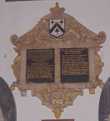 The
memorial to The
memorial toHercules Clay |
 Detail
of the inscription Detail
of the inscriptionon the monument |
10 Hercules Clay (1644)
The monument to Hercules Clay is near the east end of the south wall, in the south choir aisle. It commemorates his miraculous escape during the Civil War, how in 1643 he and his family were delivered alive by Divine Providence from a battery of cannon directed against his house which totally destroyed the building.
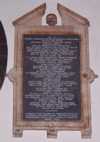 11
Henry Trewman (1655)
11
Henry Trewman (1655)
Henry Trewman was Vicar of Newark at the time of the Civil War. His memorial is a black marble monument within an alabaster frame, located on the outer wall of the north choir aisle, near to the St George’s Chapel. The Latin inscription (with a few Greek interjections) praises his virtues as a Christian minister.
 12.William Hobman (1659)
12.William Hobman (1659)
On the west wall of the church near to the font is a memorial to William Hobman. He was Mayor of Newark and Justice towards the end of the Commonwealth.
 Monument
to John Monument
to Johnand Jane Heron |
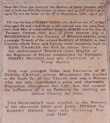 Detail
of the inscription Detail
of the inscriptionon the Heron memorial |
13 John and Jane Heron (1732)
A marble monument on the west wall of the north transept. Erected by Robert Heron in memory of his parents.
 Memorial
to Anne Taylor Memorial
to Anne Taylor |
 Detail
of the inscription Detail
of the inscription |
14 Anne Taylor (1757)
On the east wall of the north transept, facing the monument to John and Jane Heron is a marble memorial erected to their youngest daughter, Anne Taylor, wife of Dr Robert Taylor, Physician Extraordinary to the King. It is in marble, comprising a profile bust surmounting a detailed inscription, and it is executed by Roubiliac.
 The
memorial to The
memorial toThomas Spragging |
 The
monument commemorating The
monument commemoratingMargaret Spragging and her mother |
15 Margaret Spragging (1803) and
16 Thomas Spragging (1814)
These two monuments near the vestry door on the south wall in the choir aisle were designed and made by the architect and sculptor James Wallis. They commemorate Thomas Spragging, Senior Alderman of Newark, his wife Margaret and Margaret Spragging’s mother, Tomazin Tattersall.


